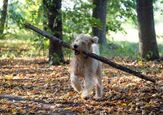Our dogs are family, and watching them transition into their golden years is truly a privilege, but it’s also undeniably bittersweet. We want nothing more than to ensure their remaining time is filled with comfort, joy, and peace. However, this new chapter of their lives introduces potential challenges, such as stiffness, less table footing, and perhaps a bit of confusion. This is where we step in.We have the power to make their home environment not just safe, but a true sanctuary for them as they navigate the changes that come with aging. You don’t need a full renovation; just a strategy focusing on smaller, targeted changes that address key concerns, like mobility, failing vision, temperature sensitivity, and overall safety. This guide will help you identify creative, practical, and highly effective ways you can adapt your home to your pup’s changing needs.Mobility and Joint ComfortFor many senior dogs, the first noticeable sign of aging is a change in how they move. Arthritis, joint stiffness, and muscle weakness can all make moving through their once familiar and comfortable home into a painful obstacle course. Minor changes throughout your home can help to restore your dog’s confidence and prevent strain and injury. Traction Solutions Hardwood, tile, and laminate floors are comfortable for us, but they can be terrifying for a dog with achy, painful joints. The slippery surfaces force them to splay their legs, putting extreme stress on their hips and knees just to stand up. A single slip on any surface could cause a serious injury. Consider placing floor runners and area rugs in strategic places throughout your home. You don’t need to carpet the entire house; just focus on creating a “traction highway” in high-traffic areas. For example, place non-slip rugs along the path from their bed to the front door, from the living room to their food bowls, and around any area where they frequently hang out or stand up. For my senior girl, Daviana, this included creating a pathway into my home office where she would accompany me during my workday. Even a basic plush rug can be a hazard if it slides out from under them. If your favourite rug isn’t non-slip, consider using a rubber or specialized anti-slip rug pad underneath to give it that extra traction boost. Are new rugs throughout your house out of your budget? Rugs can be expensive! A budget-friendly solution is to place yoga mats in the key areas where traction is needed. Finally, take a moment to consider your dog’s paws and paw pads. Keep the fur between the paw pads neatly trimmed if your pup lets you handle them. Long hair here reduces their natural grip. You can also use paw wax or dog-specific traction socks with rubber grips to help them navigate slick floors more effectively. Ramps and Steps Gone are the days when your dog effortlessly dove onto the couch or flew up the steps with ease. Why? Jumping, especially the sudden impact of jumping down, can be really hard on stiff joints. Eventually, the pain becomes too much, and your dog must make the difficult decision to give up these once-enjoyable experiences. But that doesn’t have to be the case! You can help your pup navigate the same pathways without the strain. For accessing furniture or getting in and out of the car, a low-incline pet ramp is generally safer and easier on the joints than pet stairs. There are adjustable and aesthetic options to suit your home, as well as compact, travel-friendly ramps for your car. If your senior dog is no longer able to navigate a full set of stairs in your house, you need to block their access entirely. This could be done by closing a door to block a portion of your home, if possible, or by using a safety gate directly at the stairs themselves. If your senior pup must access another floor, a lifting harness may be necessary. This requires physical effort from you and should only be done if the pathway is clear. Elevated Food and Water Bowls When it comes to mealtime, consider switching to elevated food and water bowls. This simple change keeps their head at a comfortable level, reducing the need to strain their neck, shoulder, and pack while they eat and drink. You can purchase a raised feeder, or for a more budget-friendly solution, consider placing your dog’s dishes on a cardboard box and cutting a hole to hold the dish securely in place. Orthopedic Bedding Your senior dog will spend more time resting during this stage of their life than they have ever before. Their old plush bed is no longer enough. If they sink into the overly soft bed, it can lead to stress on pressure points and uncomfortable sleeping positions, making their already stiff, sore joints even more painful. Instead, they need more targeted support. A high-quality orthopedic or memory foam bed is the single best investment you can make for your dog’s joint comfort. It contours to their body, evenly distributing weight and relieving pressure points, while still creating a cozy place to rest. This means less pain and better sleep. Look for a bed that is low to the ground or has a low entry point so your dog doesn’t have to step up or over a barrier to get in. Place several comfortable beds strategically throughout the house in the areas where your pup spends most of their time. This could include near their food dish, beside your favorite chair, or in a quiet corner. This will ensure they are never far from a comfortable resting place, especially when they feel tired, and won’t be tempted to strain themselves by walking long distances to take a much-needed rest.


























